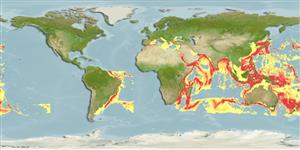Amphibalanus amphitrite (Darwin, 1854)
Purple acorn barnacle| Native range | All suitable habitat | Point map | Year 2050 |

|
| This map was computer-generated and has not yet been reviewed. |
| Amphibalanus amphitrite AquaMaps Data sources: GBIF OBIS |
Upload your photos
Google image |
No photo available for this species.No drawings available for Balanidae.
Google image |
No photo available for this species.
Classification / Names Common names | Synonyms | CoL | ITIS | WoRMS
Thecostraca | Balanomorpha | Balanidae
Environment: milieu / climate zone / depth range / distribution range Ecology
Sessile; brackish; depth range 0 - 4177 m (Ref. 107353). Tropical
Distribution Countries | FAO areas | Ecosystems | Occurrences | Introductions
Circumglobal.
Length at first maturity / Size / Weight / Age
Maturity: Lm ? range ? - ? cm Max length : 3.0 cm WD male/unsexed; (Ref. 7493)
Intertidal (Ref. 81522); Littoral to sublittoral fringe areas; known as a fouling species (Ref. 81749) - on piers, pontoons, and boat hulls (Ref. 102838). In sheltered (Ref. 125338) to exposed rocky shores. Can be found on the shells of predatory gastropods Reishia clavigera and Cellana toreuma (Ref. 127116). Part of both epibenthic and arboreal communities in mangrove areas (Ref. 128397). Sessile suspension feeder (Ref. 125928).
Life cycle and mating behavior Maturity | Reproduction | Spawning | Eggs | Fecundity | Larvae
Members of the superorder Thoracica are mostly hermaphroditic. Broadcast spawners, fertilization occurs in the mantle cavity. Life cycle: Eggs hatch into planktonic nauplii and leave the mantle cavity. Afterwards, they undergo six naupliar instars succeded by nonfeeding cypris larva (settling stage) which later metamorphose into adults.
Main reference
References | Coordinator | Collaborators
Paulay, G. and A. Ross. 2003. (Ref. 7493)
IUCN Red List Status (Ref. 130435)
CITES status (Ref. 108899)
Not Evaluated
CMS (Ref. 116361)
Not Evaluated
Threat to humans
Human uses
| FishSource |
Tools
More information
Internet sources
BHL | BOLD Systems | CISTI | DiscoverLife | FAO(Publication : search) | Fishipedia | GenBank (genome, nucleotide) | GloBI | Gomexsi | Google Books | Google Scholar | Google | PubMed | Tree of Life | Wikipedia (Go, Search) | Zoological Record
Estimates based on models
Preferred temperature
(Ref. 115969): 2.8 - 13.7, mean 4.5 (based on 1972 cells).
Resilience
(Ref. 69278):
High, minimum population doubling time less than 15 months (K=0.44-0.47).
Price category
(Ref. 80766):
Unknown.


